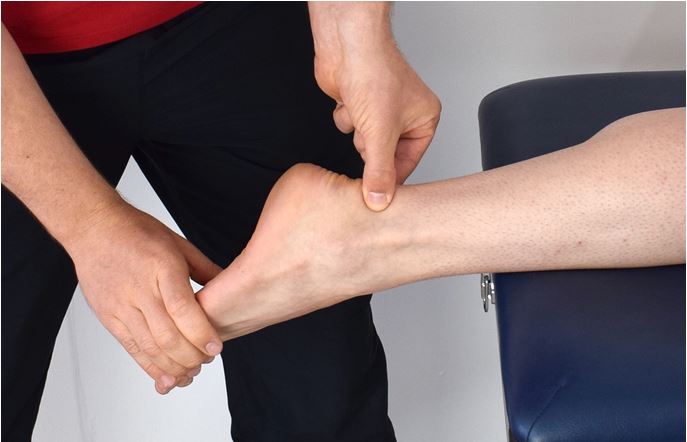 The Achilles tendon is an integral part of your body and your ability to walk. This tendon is the largest in your body, it runs down the back of your leg and connects your calf muscle to your heel bone. The Achilles tendon is a very strong part of the body but can be susceptible to inflammation and injury. Anyone can experience Achilles tendon pain, inflammation, tendinitis, or rupture.
The Achilles tendon is an integral part of your body and your ability to walk. This tendon is the largest in your body, it runs down the back of your leg and connects your calf muscle to your heel bone. The Achilles tendon is a very strong part of the body but can be susceptible to inflammation and injury. Anyone can experience Achilles tendon pain, inflammation, tendinitis, or rupture.
Causes for Achilles tendon pain can be related to various sports activities or simply overuse. Injuries sustained to the Achilles tendon are not limited to people who are incredibly active, there can be significant Achilles pain or inflammation caused by wearing improper footwear, having fallen arches or tense leg muscles.
Discovering that you have pain in your Achilles tendon can be frustrating. Stretching, walking, or standing on your toes can be uncomfortable. Over time, these symptoms can disappear on their own, but there is the risk of rupturing your Achilles tendon if the problem remains untreated.
A ruptured Achilles tendon happens suddenly and the pain is acute. Bruising and swelling is not uncommon for this type of injury, and walking is very difficult with the afflicted tendon. Taking preventative measures to avoid a ruptured Achilles tendon is essential if you discover that your Achilles is sore, swollen, or painful.
Treatment
If you discover that your Achilles tendon is sore or swollen, it is important to start treating the ankle right away. There are many ways to help alleviate the discomfort of a sore Achilles tendon. Treating the Achilles tendon can relieve pain and swelling significantly and prevent further strain on the tendon. A course of action should be developed depending on how serious the Achilles injury is. Seeing a doctor help find the best-recommended treatment should always be considered before taking any measures to treat the Achilles tendon.
Most physicians will recommend a combination of solutions for your Achilles tendon injury depending on your needs. Different routines for treating Achilles injuries include:
Rest
 Resting your affected leg will help heal the Achilles tendon tissue quickly. Depending on how severe the injury is, you may need to exercise with caution, but if the tendon is severely injured, there may be a need to rest for a great length of time. Avoiding the application of pressure on the troubled ankle is the best way to rest your leg, and this will most likely require crutches that you can get from your doctor.
Resting your affected leg will help heal the Achilles tendon tissue quickly. Depending on how severe the injury is, you may need to exercise with caution, but if the tendon is severely injured, there may be a need to rest for a great length of time. Avoiding the application of pressure on the troubled ankle is the best way to rest your leg, and this will most likely require crutches that you can get from your doctor.
Elevation
Elevating the ankle that is bothering you can help reduce swelling. Raising the leg above heart level is the best way to do this. Alternating between elevation and motion of the leg can improve circulation, which will allow oxygenated blood to reach the area and bring down inflammation.
Pain Relief
Taking over the counter non-steroidal anti-inflammatory medication such as ibuprofen or aspirin can help reduce inflammation and swelling rapidly. Check the labels for side-effects and health concerns that can be affected by any medication you’re considering taking.
Ice
Ice is an excellent solution for inflammation and swelling and can help reduce these symptoms quickly. Using ice in increments of 15 to 20 minutes at a time is the safest way to avoid frostbite and allow for healing.
Compression
Using an elastic compression band around your ankle and lower leg can help curb swelling and reduce stress to the Achilles tendon.
Proper Footwear
Having the proper footwear can help alleviate stress to the Achilles tendon. Using heel lifts or shoe inserts in your shoes from Protalus.com can also help to reduce pressure on the Achilles tendon when you walk.
Stretching and Strengthening Exercises
Talk to your doctor about different strengthening exercises you can practice to help stabilize your ankle and Achilles when you walk or exercise. Learning stretches that relieve tension in your Achilles can help to reduce pain and will help you avoid further injury. Practicing exercise routines like yoga can help maintain the overall health and flexibility of your body.
Surgery
Talking to your health care provider about the severity of your Achilles tendon and whether it has ruptured can help to determine if you’ll need to have surgery to prepare the damaged tissue. Surgery isn’t recommended if the problems associated with your Achilles have not persisted for at least 6 months. Other methods of treatment should be applied before opting into a surgical procedure.
Surgery for the Achilles tendon usually consists of a procedure that lengthens one of the muscles in the calf of the afflicted leg, allowing for the patient to have a larger range of motion when involved in any physical activity including walking.
Recovering
Recovery of an injured Achilles tendon depends on the severity of the injury and whether or not you’ve gone through surgery to help manage the issues associated with your Achilles injury. Your main focus when recovering from problems associated with Achilles tendon pain, swelling, or surgery should be resting the Achilles that is injured. Not applying pressure or intense motion in the distressed ankle is the best way to speed up recovery. Decreasing the intensity of a workout or ceasing to exercise while the Achilles heal will aid in recovery.
If you must go through surgery to help ease problems with your Achilles tendon, making sure to take the proper steps to care for your Achilles and the incision site is important. You may experience swelling or bruising where incisions were made and in the lower leg and ankle. Using ice will help to reduce inflammation.
After surgery, your doctor may put on a cast or give you a walking boot that you should use for 6 to twelve weeks. Your Achilles tendon will get stronger slowly over time, but complete use of your leg may not come for several months. Doing physical therapy and learning rehabilitation exercises can help build strength in your lower leg and ankle after surgery. Speak with your doctor about when the right time to begin these processes would be. Eventually, over time, your Achilles tendon will be strong and able to operate without swelling or pain.
ABOUT THE AUTHOR:
Eva Allen is a passionate cyclist, author, and blogger. She is very passionate about writing on different types of women’s bikes, accessories, health, fitness and more. She regularly writes on sportsly.net

